A week ago my grafted Lophophora williamsii (SB 854; Starr Co, Texas) celebrated its 6th anniversary sitting on top a sturdy Trichocereus pachanoi stock. The plant was grafted as a tiny seedling and in 6 years the main head has grown to a width of approximately 8 cm (~3.2'') – the 3 largest offshoots are 6 cm (~2.4'') wide each. The main head seems to have stabilized at 8 ribs while the largest pups are in transition from 5 to 8 ribs.

Lophophora williamsii graft, top view
The last couple of weeks the plant has “popped out” fruits resulting from last years late flowers. This season’s first flower appeared a couple of days ago and was promptly (self-)pollinated – according to previous experience this should result in another fruit in 7-8 weeks time.

Grafted Lophophora williamsii, first flower of the season
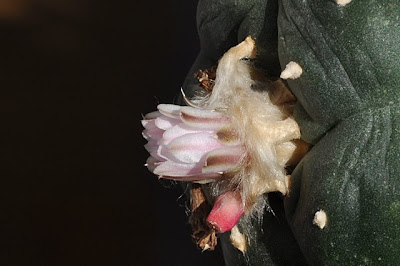
Lophophora williamsii flower and fruit
I’ve already harvested more than 120 seeds from this plant alone this season. As this variety of Lophophora williamsii is not particularly frost hardy I’m not sure if I’ll start all these seeds as the seedlings will have to go to my coldhouse – maybe I should set up a “swap shop” instead ;-)

Lophophora williamsii fruits
I’m wondering for how long the Trichocereus pachanoi stock will be able to support the rather large Lophophora williamsii scion. This is my oldest graft so I have no experience to rely on regarding the actual longevity of Trichocereus stock plants; I guess time will tell.

Lophophora williamsii grafted on Trichocereus pachanoi stock
For comparison you can check the posts on the same graft as one, two, three, four, and five years old.
Wednesday, April 28, 2010
The power of grafting – 6th anniversary
Saturday, April 24, 2010
Flowering Lophophora koehresii, spring 2010
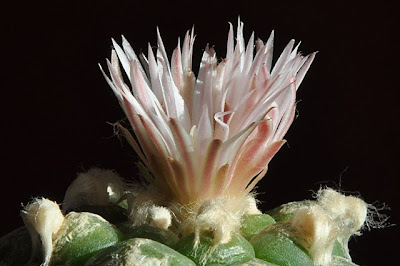
Flowering Lophophora koehresii
My grafted Lophophora koehresii (RS 1182; El Sabino, San Luis Potosí) just flowered for the first time this growing season.
The light pink flower with unusually thin petals having a darker midstripe is true to the species. What appears to be a “double-flowered” variety with extra petals in the picture above is in reality just three flowers unfolding at the same time.

Lophophora koehresii flowers, top view
The Lophophora koehresii scion was badly disfigured by spider mites but managed to outgrow some of the scarring after I started showering my plants regularly and treating them with neem oil – a treatment I intend to continue this year as it seems to be an effective means of controlling the spider mites (and with a bit of luck the plant will outgrow its defacing completely in a couple of years).

Lophophora koehresii disfigured by spider mites
The Trichocereus pachanoi stock plant hosts two different Lophophora koehresii clones (RS 1182; El Sabino, San Luis Potosí), both started from seed March 3, 2007. The first scion was grafted June 7, 2007 and when the Trichocereus pachanoi stock plant grew an offset I grafted another seedling on it May 5, 2008 (the second scion is visible in the foreground of the above picture). I intend to get seeds off this self-sterile species and just need to wait for the second Lophophora koehresii clone to flower before this “all inclusive” graft starts to produce seed ;-)
Wednesday, April 21, 2010
The killing frost – life goes on
As mentioned in two previous posts (available here and here) this winter was extremely cold and killed off large parts of the collection I grow in an unheated greenhouse. Now spring is comming and the surviving plants are getting ready to move on.
Lophophora williamsii var. echinata with fruit
Most of my Trans-Pecos peyote plants (Pecos River area, Val Verde County, Texas; JJH 8608293) made it through the winter and is now setting fruit as if to herald the beginning of the comming growing season. If you look closely you’ll even notice a few flower buds.
Trans-Pecos peyote with budding flower
The Trans-Pecos peyote is also known as Lophophora williamsii var. echinata and is more cold-hardy than other varieties of L. williamsii
My Epithelantha micromeris plants (near Belen, New Mexico; SB1327) are also busy securing the next generation.
Epithelantha micromeris with fruit, top view
I’m getting increasingly infatuated with Epithelantha - you can’t but love the complex spination and the almost shocking pink fruits ;-) As Epithelantha has also proven to be an extremely cold hardy genus I’ll probably add more of these plants to my collection in the future.
Epithelantha micromeris with fruit
I am growing these plants at my summerhouse and not seeing them as often as I could wish. Unfortunately this also means that I miss a lot of the flowers including those of the Normanbokea valdeziana and Acharagma roseana pictured below.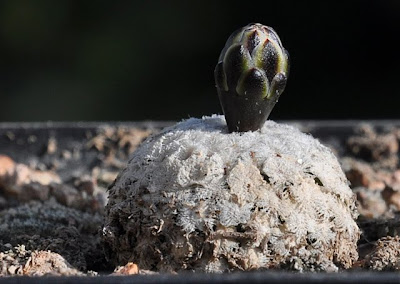
Normanbokea valdeziana about to flower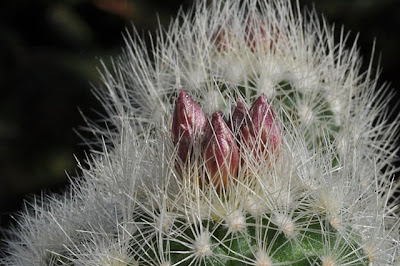
Acharagma roseana about to flower
Fortunately fruits are more persistent than flowers giving me the opportunity to enjoy sights like the orange-red berries of Escobaria missouriensis (Mesa County, Colorado; SB204)
Escobaria missouriensis with fruit
My Maihuenia patagonica are thriving after the winter but not exactly flowering or setting fruit. I don’t have much experience growing Maihuenia - I originally fell for Maihuenia poeppigii but being a completist I ordered M. patagonica seeds as well. All the M. poeppigii plants succumbed to the frost this winter while the M. patagonica plants only suffered a few casualties. I'm not sure I’m treating the plants right, though, as they are growing strangely lanky, far from the dense, clustering habit I have seen in pictures (and the plants are getting plenty of light).
Maihuenia patagonica
And now for something completely different.
My summerhouse is located on the west coast of Denmark overlooking the North Sea. This weekend the Sun set in a sky looking much more orange than usual, and slightly diffused as by a thin haze. 
The Sun setting in a haze of ashes from the Eyjafjallajökull eruptions
I take this to be caused by the Eyjafjallajökull volcano eruptions that have been sending a vast, invisible plume of grit drifting over Europe and kept most of European airspace shut down for several days. Of course one could imagine that a sunset like this was caused by a thin layer of clouds, but I have enjoyed hundreds of sunsets from my terrace and never seen anything like this before.
Sunset with a diffuse halo of refracted light – probably caused by Eyjafjallajökull ashes
On a different note, the Eyjafjallajökull volcano eruptions almost got me stuck in Amsterdam (not the worst place to be stuck in, by any means ;-) I and a colleague were supposed to have flown home in the late evening of April 15, 2010 – but as we watched more and more flights getting canceled and increasing parts of the north-western European airspace being closed down we agreed to rent a car. So in the early afternoon we set out on a long drive home – which in hindsight was an extremely wise decision as Danish airspace is only opening again today ;-)
Sunday, April 11, 2010
The killing frost – casualties and survivors
First a bit of background information so that you guys won’t believe that I am completely stupid growing Lophophora and the likes in an unheated greenhouse in Denmark: 1) Most of these plants are “surplus”, i.e. I don’t have room for them anywhere else – lately several plants have been bought specifically for the cold house, though. 2) The greenhouse is located at my summerhouse, left mostly desolate throughout winter, making it difficult to keep it reliably heated. 3) Many cactus species tolerate more frost than is generally assumed; I’m curious which. 4) The winters in Denmark have been rather mild lately, inviting experiments like this.
With this in place I’m ready to recount how the harsh winter, that has just released its cold grip of Denmark, helped me separate the wheat from the chaff (a blatant euphemism for “killing off alarmingly large parts of my collection”). Just to give an understanding of the severity of the winter, the plants saw almost constant frost for more than 10 weeks, with temperatures measured as low as -15 C (5 F) in the area where the plants grow.
Lophophora williamsii var. echinata coming out of winter
Let’s start with one of the success stories. My Trans-Pecos peyote plants are doing quite well, approximately one in eight died and the surviving plants are not too marked by the frost. The plants I'm growing are descending from material originally collected in the Pecos River area, Val Verde County, Texas (JJH 8608293). The Trans-Pecos peyote is the northernmost form of Lophophora williamsii and is also known as Lophophora williamsii var. echinata.
Trans-Pecos peyote surviving the frost
My regular (Mexican and south Texan) Lophophora williamsii plants fared much worse, less than one in ten of the larger plants survived the winter. 
One of the few surviving Lophophora williamsii var. williamsii
This corresponds well with Del Weniger’s observations:
[Lophophora williamsii var. echinata] can also survive the much more severe cold of the Big Bend. I have several times had the smaller form from south Texas [L. williamsii var. williamsii] freeze in San Antonio, while this form [L. williamsii var. echinata] growing in the same bed showed no ill effects.
In the future I'll focus more on the extreme northern forms of peyote, i.e. plants grown from material originating from Shafter, Val Verde, Big Bend and other Trans-Pecos, Texas locations. The Cactus Conservation Institute has an informative page on the differences in traits between Lophophora williamsii var. echinata and var. williamsii.

Frost killed Lophophora williamsii, Starr County, Texas
As mentioned the majority of my large “regular” Lophophora williamsii were killed by the frost. But many medium sized seedling plants actually survived while the larger plants (of the same variety) and yearling seedlings succumbed. As this pattern seems to be rather consistent for plants of the same variety, I guess I can’t write all “regular” Lophophora williamsii casualties off to genetics. My theory is that this “size-conditioned” difference in survival must be related to how well the plants were prepared for the winter, which again may be closely related to the surface-area-to-volume ratio of the plant.
The surface-area-to-volume ratio (SA:V) decreases with size, i.e. a large plant will have less surface per unit of volume than a smaller plant. If we use a half sphere as a model for a globular cactus we get a SA:V of 3/r, where r is the radius. Consequently a large plant will need relatively longer time (per unit of volume) to go flaccid and prepare properly for the winter (as all excess water needs to be evaporated through the surface (the epidermis)). Similarly seedlings are more prone to die of drought as an increased SA:V means increased exposure to the environment in general.
To play it safe the coming growing seasons I'll stop watering my large plants well before I let seedlings go drought dormant in preparation for the winter, and in general start winter preparations earlier than I have used to in the past.
I might consider crossing the surviving mature (non Trans-Pecos) plants and name the cultivar Lophophora williamsii 'Borealis' ;-)

Frost killed Leuchtenbergia principis – outside the rain is weeping
My largest Leuchtenbergia principis is dead (pictured above next to a surviving saguaro) while 3 out of 4 of my smaller Leuchtenbergia principis plants (GL 770; Sierra de la Paila) are looking happy.
Ariocarpus has turned out to be an unconditional coldhouse success. I expected my Ariocarpus fissuratus plants to make it safely through the winter as they originate from locations like Fort Stockton, Texas (JM 122) and Crockett County, Texas (SB 403), but I had doubts about my Ariocarpus kotschoubeyanus var. macdowellii plants (SB 100; El Pilar, Coahuila), and had accepted that I would probably loose my Ariocarpus retusus (SB 310; Cuesta la Muralla, Coahuila). Amazingly they all survived the winter in great style almost looking lush and vigorous, like a winter swimmer surfacing with renewed energy after a cold plunge.

Surviving Ariocarpus, Epithelantha, and Leuchtenbergia plants
Epithelantha is another seriously cold tolerant genus. My Epithelantha micromeris var. greggii plants (Cuesta la Muralla, Coahuila, Mexico) all made it; one is seriously damaged, though – it looks like the root is dead while the crown looks fine, so I hope to be able to re-root it. The Epithelantha bokei plants (SB 416; Brewster Co, Texas) also look fine, but due to the extremely dense spination it is hard to say for sure if they are completely undamaged. Strangely the cold has taken the hardest toll on my regular Epithelantha micromeris (SB1327; near Belen, New Mexico) – this variety of E. micromeris is from the northernmost known locality of the species so I had expected the plants to cope better with the frost.

Surviving Obregonia denegrii plants
Last summer I moved a handful of Obregonia denegrii seedlings (VVZ 163; San Vicente, Tamaulipas) to the coldhouse. I really didn’t expect these plants to be cold hardy, but didn’t have room for them anywhere else. Surprisingly approximately two thirds of the plants survived as illustrated in the above picture (the surrounding pots are not empty, each contain a rather large L. williamsii killed by the cold).
Other success stories are Normanbokea valdeziana, Homalocephala texensis, and Mammillaria meiacantha which all made it through the winter without casualties – the Normanbokea plants are even budding. Acharagma roseana is another species that’s shaking off the winter blues and getting ready to bloom – in general Acharagma seems to handle the cold pretty well, even most of my yearling Acharagma aguirreana seedlings survived. Most Escobaria and Echinocereus obviously had minimal problems with the frost.

Frost killed Lophophora williamsii turning to mush
As mentioned above the majority of my larger, regular Lophophora williamsii plants were killed by the frost, but the more tender Lophophora species like Lophophora diffusa and L. fricii are completely eradicated – I’ll probably not experiment further with these species in the coldhouse, the exception maybe being montane varieties of Lophophora fricii.

Dead Lophophora diffusa
Other species that are completely wiped out include Matucana madisoniorum, an unknown Echinopsis hybrid, Ferocactus glucescens (PP 1354), Lithops lesliei (not exactly a cactus, I know ;-), and Harrisia jusbertii. Surprisingly all my Mammillaria grahamii also died – I had expected this species to be more cold hardy.
Most of my saguaro cactus (Carnegiea gigantea) also succumbed to the frost – 4 plants look like they might survive, most of them badly damaged, but it is too early to say.
I need to start building a new collection of grafting stock – all Trichocereus plants that I grew in the coldhouse are dead, including Trichocereus pachanoi, T. peruvianus, Trichocereus 'Tom Juul’s Giant', and a Penis Cactus… they are all gone. Even plants that were well prepared for the winter died, so Trichocereus is definitely not as tolerant to frost as I had expected.
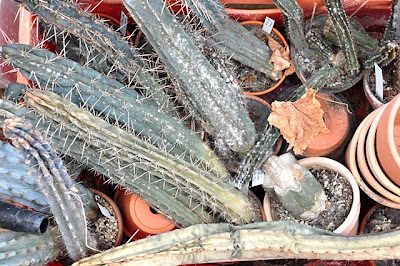
Decomposing Trichocereus plants
To put the death toll into perspective this is the coldest winter in 14 years in Denmark (followed by March, a month with the most extreme temperature fluctuations in 14 years, which were not very becoming to my struggling plants either). The frost set in just before Christmas and only lifted again in the beginning of March. The lowest temperatures measured in the area were as low as -15 C (5 F).

Outdoor temperature in late January
Once in a while short bursts of thaw set in quickly followed by frost (as indicated by the above graph), making the conditions even harder for the plants.

Outdoor temperature in mid February
The temperature measurements come from a semi-professional weather station located approximately 1.5 km (~ one mile) from where I grow my plants, so these temperatures are representative for those that my plants where exposed to.
To end on a positive note I expect the frost to have killed off many pests also (including red spider mites). Also, I got an affirmative confirmation that it is actually possible for peyote to survive rather extreme conditions in an unheated greenhouse in Denmark... and I got plenty of room for new plants ;-)
Sunday, April 04, 2010
Flowering Lophophora fricii
I don’t have many mature Lophophora fricii plants in my collection (but have quite a few seedling plants “in the works”). Last year one of my few adult L. fricii plants put out several of its characteristic large, striking pink flowers, reminding me why I need to grow more plants of this species ;-)

Lophophora fricii flower
This particular Lophophora fricii plant was started from seed in the spring of 2002 and is, after a slow start (and some neglect), developing into a nice mature specimen.

Flowering Lophophora fricii
I don’t have any locality information for this plant; it was started from seed before I went nerdy and started bothering about “details” like that ;-)
All Time Most Popular Posts
-
Lophophora williamsii (peyote) populations have diminished in large areas of South Texas where peyoteros harvest the cactus for ceremonial ...
-
On various occasions I've been asked what growing media I'm using for my cactus plants. I don't have a set soil mix recipe as su...
-
Below is a list of retailers/nurseries selling cactus seed and plants. I've only listed vendors I've done business with. If you ar...
-
Most cacti are easily grown from seed - and with a little patience and care they can be grown into beautiful plants. Lophophora williamsi...
-
In last month’s post on the troubled Texan peyoteros I referred to Anderson’s article on the peyote situation in Texas. Given the importanc...
-
Yet another slightly off topic and probably not entirely politically correct post, but I couldn’t help noticing the similarity of my monstr...
-
Flowering stand of San Pedro cacti (Trichocereus pachanoi) To me the main draw of the San Pedro cactus ( Trichocereus pachanoi (syn. Ech...
-
In the June 2008 issue of the Cactus & Co magazine Jaroslav Šnicer, Jaroslav Bohata, and Vojtěch Myšák described a new Lophophora spec...
-
There seems to be an increased focus on the alarming Texas peyote situation. A couple of weeks ago the Houston Press published a mournful, i...
-
I spent two weeks working in Delhi, India during January. I had one weekend off and had planned to spend it in Delhi at my own leisure, but ...


















